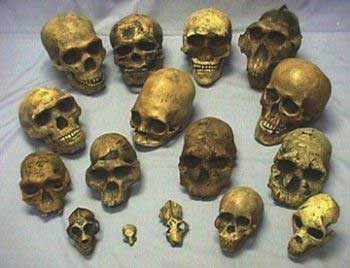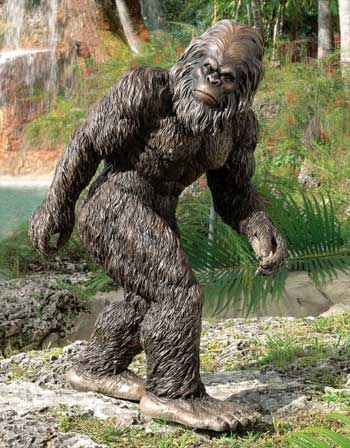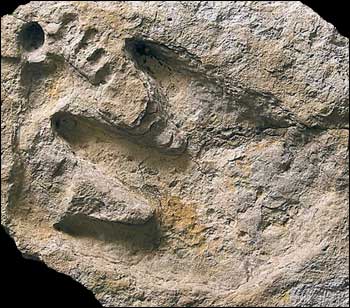
(From the Talk Origins Archive)
The usual creationist response to hominid fossils is to claim that there are no intermediates; each one is either a human or an ape. It doesnʼt matter that some of the “humans” have a brain size well below the normal human range, heavy brow ridges, no chin, and teeth larger than modern ones set in a projecting jaw, or that some of the “apes” were bipedal, with very humanlike teeth, and brains larger than those of similar sized apes. There are some skulls which cannot be reliably assigned to either genus.
(Willis 1989)
This is exactly what we would expect if evolution had occurred. If, on the other hand, creationism was true and there was a large gap between humans and apes, it should be easy to separate hominid fossils into humans and apes. This is not the case. As will be shown, creationists themselves cannot agree which fossils are humans and which are apes.
It would not matter even if creationists could decide where to put the dividing line between humans and apes. No matter where it is placed, the humans just above the line and the apes just below it will be more similar to one another than they will be to other humans or other apes.
Although there are many variants of creationism, the following sections deal only with the arguments of young-earth creationists, who hold to a very rigid literal interpretation of the Bible. They typically believe that the earth was created less than 20,000 years ago, in the space of six 24-hour days. Old-earth creationists usually accept the age of the earth given by geologists (4.6 billion years), but differ considerably in their acceptance of the theory of evolution.
Young Earth Creationists Admit Numerous Hominid Fossils Exist
“I was surprised to find that instead of enough fossils barely to fit into a coffin, as one evolutionist once stated [in 1982], there were over 4,000 hominid fossils as of 1976. Over 200 specimens have been classified as Neandertal and about one hundred as Homo erectus. More of these fossils have been found since 1976.”
— Michael J. Oard [creationist], in his review of the book, Bones of Contention: A Creationist Assessment of Human Fossils, in the Creation Research Society Quarterly, Vol. 30, March 1994, p. 222
“The current figures [circa 1994] are even more impressive: over 220 Homo erectus fossil individuals discovered to date, possibly as many as 80 archaic Homo sapiens fossil individuals discovered to date, and well over 300 Neandertal fossil individuals discovered to date.”
— Marvin L. Lubenow [creationist], author of Bones of Contention: A Creationist Assessment of Human Fossils, in a letter to the editor of the Creation Research Society Quarterly, Vol. 31, Sept. 1994, p. 70
The evidence from ape fossils primitve apes are not the same as modern apes in some ways primitive ape anatomy more closely resembles modern human anatomy than it resembles modern ape anatomy
Over 100 species of primitive apes are known to have existed during the Miocene period in Europe and Africa. Those primitive ape species appeared before the first human-like apes (Australopithecines). And the primitive apes all differ from modern great ape species in that the primitive apes were all relatively nearer to modern day human skeletal anatomy than todayʼs great apes are. For instance, the primitive apes all had small hands, and had legs and arms the same length; while modern great apes all have large hands with long fingers, and their arms are longer than their legs. The primitive apes also had no simian shelf in their jaws, again like modern humans; while the modern great apes all have a simian shelf in their jaws, unlike modern humans. [See David R. Begun, “Planet of the Apes,” Scientific American, August 2003] So the general skeletal anatomy of the earliest known apes were nearer to human than is the skeletal anatomy of modern apes that have diverged and gone in a separate anatomical direction.
Non-Fossil Evidence
Man and chimp are nearer each other genetically than either of them are to the other apes. One early estimate of the genetic distance between man and chimp was done in the 1970ʼs using the technique of pairing up the two halves of DNA strings from different species to see what percentage of the DNA stands would join together and what percentage did not. Humans and great apes were found to be no more dissimilar than sibling species of fruit flies:
“We have obtained estimates of genetic differentiation between humans and the great apes no greater than, say, those observed between morphologically indistinguishable (sibling) species of Drosophila flies (fruit flies).”
— Elizabeth J. Bruce & Francisco J. Ayala (Dept. of Genetics, Univ. of Calif.), “Humans and Apes Are Genetically Very Similar,” Nature, Nov. 16, 1978, Vol 276, p. 265.
“New genetic evidence demonstrates that lineages of chimps (currently Pan troglodytes) and humans (Homo sapiens) diverged so recently that chimps should be [reclassified] as Homo troglodytes. The move would make chimps full members of our genus Homo, along with Neandertals, and all other human-like fossil species. ‘We humans appear as only slightly remodeled chimpanzee-like apes,’ says the study… Within important sequence stretches of these functionally significant genes, humans and chimps share 99.4 percent identity. (Some previous DNA work remains controversial. It concentrated on genetic sequences that are not parts of genes and are less functionally important, said Goodman.)…”
— “Chimps Belong on Human Branch of Family Tree, Study Says” John Pickrell in England for National Geographic News May 20, 2003
Lastly, if you were to compare the genetic distance not between man and chimp, but between man and their common ancestor, the genetic distance must be halved once again. So the genetic distance is not [unbridgeable] by any means. Even one of the founders of I.D., Michael Denton, has recognized the [bridgeable] nature of the genetic distance between species and has [abandoned] his former “anti-common-descent” views as a result:
“One of the most surprising discoveries which has arisen from DNA sequencing has been the remarkable finding that the genomes of all organisms are clustered very close together in a tiny region of DNA sequence space forming a tree of related sequences that can all be interconverted via a series of tiny incremental natural steps. So the sharp discontinuities, referred to above, between different organs and adaptations and different types of organisms, which have been the bedrock of antievolutionary arguments for the past century, have now greatly diminished at the DNA level. Organisms which seem very different at a morphological level can be very close together at the DNA level.”
— Michael Denton, Natureʼs Destiny (chapter 12, p. 276)
Some creationists try to counter the evidence of incredibly small differences between the human and chimp genomes with arguments such as this one:
“Humans have 3 billion ‘letters’ (base pairs) of DNA information in each cell, so a two percent difference [between human and chimp genomes] is actually 60 million ‘spelling errors!’ Of course, this is not ‘error’ but twenty 500-page books worth of new information that needs to be explained by mutation and selection.”
— Jonathan Sarfati [creationist], Refuting Evolution 2, p. 186
Response: “Sarfati is trying to classify every difference in the genomes of humans and chimps as ‘new information’ that would have to be introduced either into the human or the chimp genome since the last common ancestor of humans and chimps. What he neglects is the fact that the vast majority of those differences are single nucleotide differences in genes (or, more often, in stretches of noncoding DNA) that merely change one amino acid in a protein (with no change in function), or make no change to the protein at all, or occur in DNA sequences that make no protein. Others are stretches of DNA of which one species has more than one copy — to the other speciesʼ single copy of that same stretch of DNA (such duplications are common mutations in the genome) — or that have simply moved from place to place among the noncoding DNA, or similar differences. So the facts are not as Sarfati presents them, but rather the vast majority of differences between human and chimp DNA have been identified, and they are the most common sorts of changes that mutations have been observed to produce. Maybe there are some variant genes of a type that mutations have not been known to produce, but Sarfati does not make any such distinction, nor provide evidence of such a discovery. What we do see in the vast majority of cases are simple duplications, deletions, translocations, and point alterations of stretches in the other genome, all of which have been observed to occur naturally.”
— Steven J.
Chromosomal Evidence
Normally, each chromosome is shaped like a long hot dog wearing an extra-tight slimming girdling in the middle, and that tapered region in the center of each chromosome is where the “centromere” is located. Human Chromosome #2 contains remnants of a second centromere that would be expected if our chromosome was once two separate chromosomes each with their own centromere. In the great apes today they have two chromosomes, #2 & #3 whose banding patterns match up with the extra-long single Human Chromosome #2. In other words, Human Chromosome #2 appears to have resulted from the fusion of two ancestral chromosomes still found in all the living species of apes, and that explains why Human Chromosome #2 contains the remnant of a second centromere. Moreover, the chromosomal number and length and distinctive banding patterns of all the other chromosomes found in both humans and chimpanzees line up extremely well, as can be seen at the websites below that feature photos and diagrams.
See the article “Human Chromosome 2 is a fusion of two ancestral chromosomes” by Alec MacAndrew
as well as the article, “Comparison of the Human and Great Ape Chromosomes as Evidence for Common Ancestry”
For further Human and Chimpanzee chromosome comparisons see Beth Kramerʼs site.
Also click to sub-page
which provides a detailed matching of human and chimp chromosomes 1-4. Note how the chromosomal banding patterns on the second chromosome in humans lines up with those in two shorter chimp chromosomes, while all the other chromosomal numbers and banding patterns of chimp and human match up quite closely. For matchings on other chromosomes
Note: humans have 22 chromosomes (called autosomes), plus the X and Y.
For a beautiful image matching all the chromosomes of four hominids — human, chimpanzee, gorilla, and orangutan. Finally see the Hominoid Phylogeny (ancestral tree) based on these chromosome comparisons





